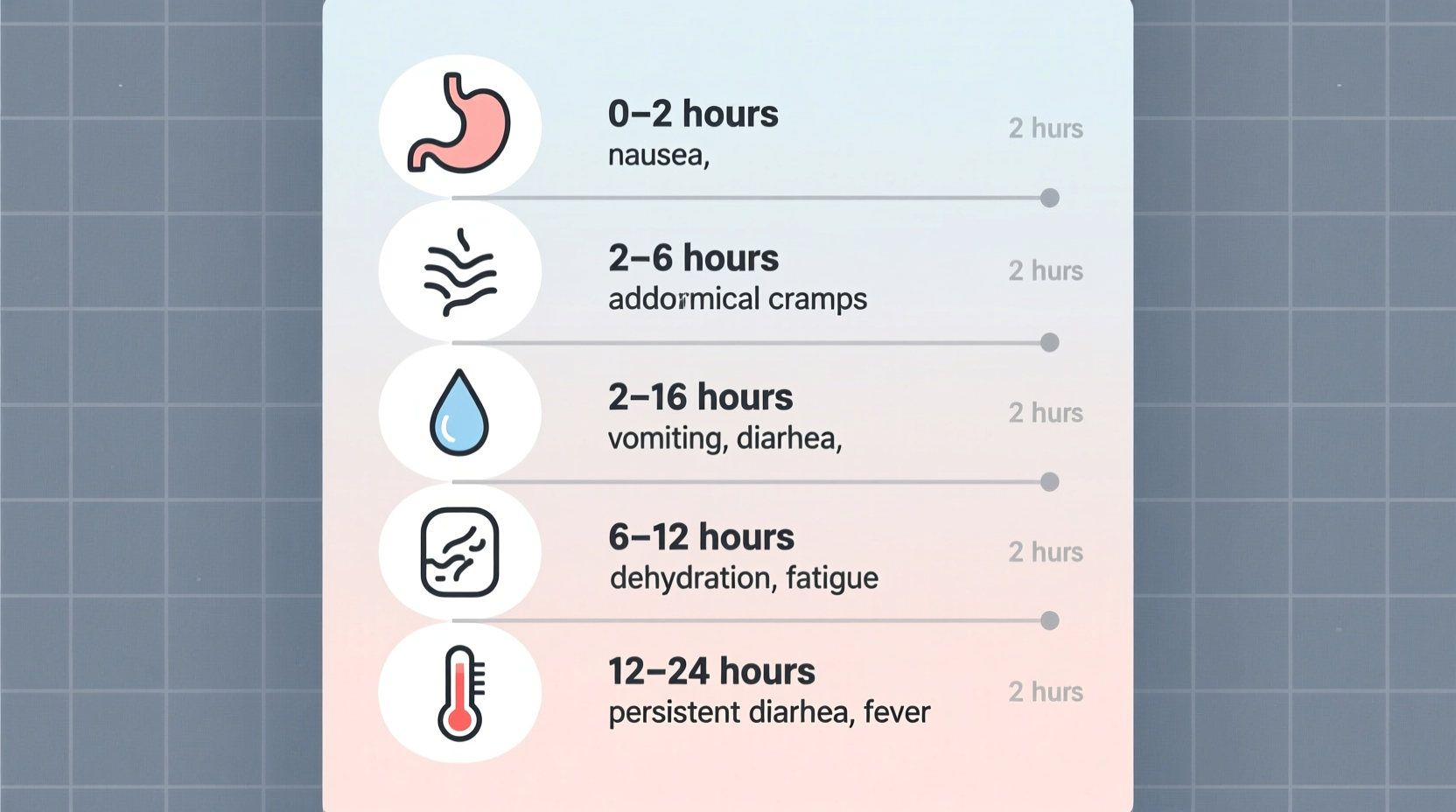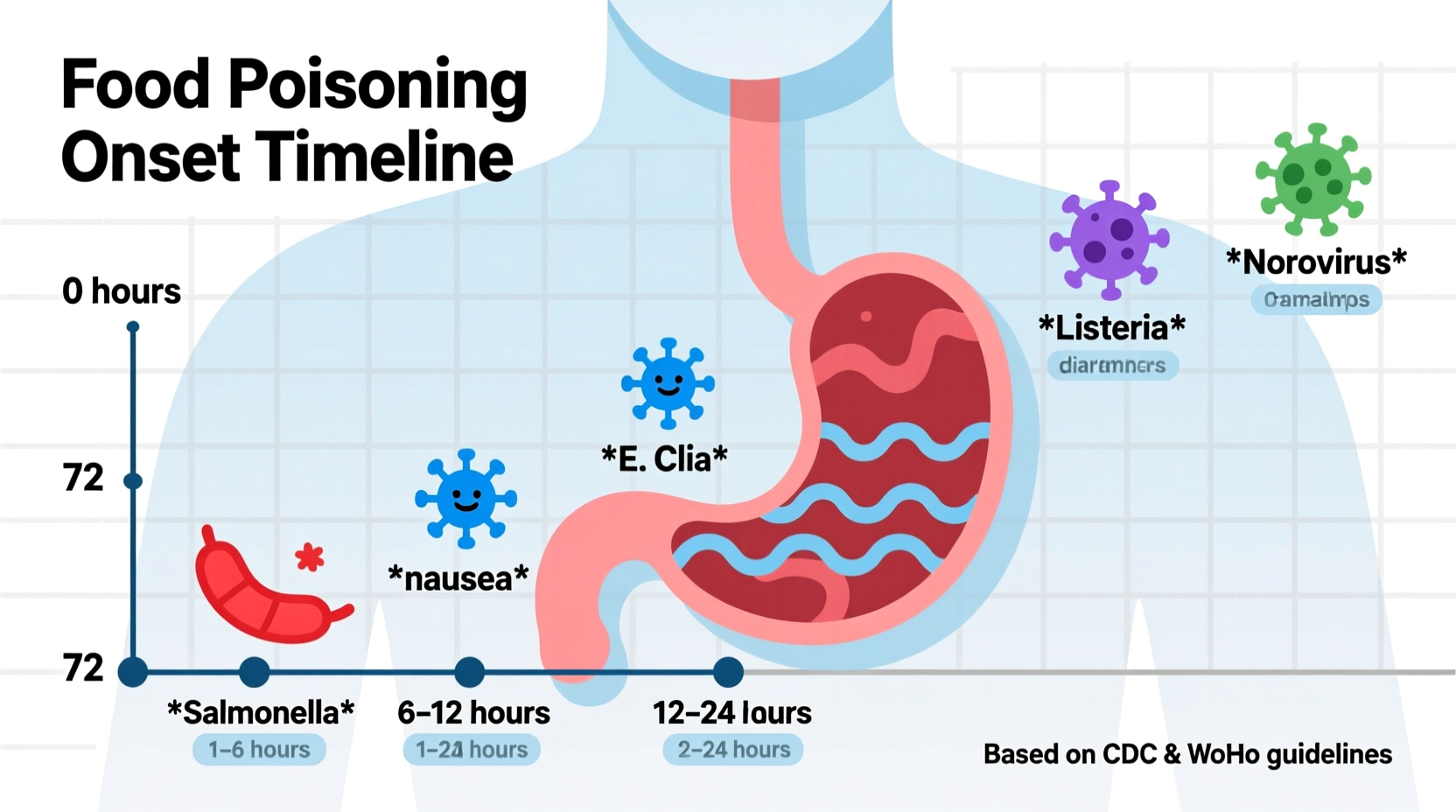Understanding exactly how fast does food poisoning kick in is crucial for proper treatment and prevention. When your stomach starts churning after a meal, knowing the typical timeline helps distinguish foodborne illness from other digestive issues and determines when to seek medical care. This guide provides evidence-based information on symptom onset times, organized by pathogen type, so you can respond appropriately when food safety fails.
Why Timing Matters in Food Poisoning Cases
The incubation period—the time between consuming contaminated food and symptom onset—provides critical clues for identifying the responsible pathogen. Medical professionals use this timeline alongside symptom patterns to determine appropriate treatment. For home care, recognizing whether your symptoms align with common food poisoning timelines helps you decide between self-treatment and seeking emergency care.
Food Poisoning Onset Timeline: What to Expect When
| Onset Timeframe | Common Pathogens | Typical Symptoms | High-Risk Foods |
|---|---|---|---|
| 30 mins - 6 hours | Staphylococcus aureus, Bacillus cereus | Severe nausea, vomiting, stomach cramps | Leftover rice, dairy products, meats |
| 6 - 24 hours | Salmonella, E. coli, Campylobacter | Diarrhea (sometimes bloody), fever, cramps | Raw eggs, undercooked poultry, unpasteurized milk |
| 1 - 3 days | Norovirus, Shigella | Watery diarrhea, vomiting, headache | Ready-to-eat foods, shellfish, contaminated water |
| 3 - 14 days | Listeria, Hepatitis A, Giardia | Fever, muscle aches, prolonged diarrhea | Soft cheeses, deli meats, raw produce |
Immediate Onset (30 Minutes to 6 Hours)
When food poisoning symptoms start within an hour, you're likely dealing with preformed toxins rather than live pathogens multiplying in your system. Staphylococcus aureus produces heat-stable toxins in foods left at room temperature, causing sudden, violent vomiting without fever. Bacillus cereus, common in improperly stored rice, triggers similar rapid-onset symptoms.
What to do: Focus on hydration with small sips of clear fluids. Avoid anti-diarrheal medications initially as they can trap toxins. Most cases resolve within 24 hours without complications, but contact a healthcare provider if vomiting persists beyond 12 hours.
Short-Term Onset (6 to 24 Hours)
This most common food poisoning timeframe indicates bacterial pathogens actively multiplying in your digestive system. Salmonella from raw eggs or poultry typically appears 6-48 hours after exposure, while E. coli from undercooked ground beef often strikes within 1-3 days. These infections cause more prolonged symptoms than toxin-based illnesses.
The CDC reports that Salmonella causes approximately 1.35 million infections annually in the United States, with symptoms usually developing 6 hours to 6 days after exposure. During this critical window, proper hydration becomes essential as diarrhea and vomiting accelerate fluid loss.
Delayed Onset (1-14 Days)
Some pathogens have longer incubation periods that confuse diagnosis. Listeria, dangerous for pregnant women and immunocompromised individuals, may take 1-4 weeks to manifest. Hepatitis A virus from contaminated produce or shellfish typically appears 15-50 days after exposure.
Important context: When symptoms develop more than 72 hours after eating, people often misattribute them to "stomach flu" rather than foodborne illness. The FDA emphasizes that recalling exactly what you ate during the suspected exposure window significantly improves accurate diagnosis.
Factors That Accelerate or Delay Symptoms
Several variables influence how quickly does food poisoning kick in for any individual:
- Pathogen type: Toxins act fastest; viruses and parasites take longer
- Consumed quantity: Larger doses often cause quicker, more severe symptoms
- Individual health: Weakened immune systems may respond slower
- Food matrix: Fatty foods can delay gastric emptying, prolonging incubation
- Stomach acidity: Medications reducing acid may allow more pathogens to survive

When to Seek Immediate Medical Attention
While most food poisoning cases resolve without intervention, certain red flags require prompt medical evaluation:
- Symptoms beginning within 30 minutes of eating (possible chemical poisoning)
- Blood in vomit or stool
- Signs of severe dehydration (dizziness, reduced urination, dry mouth)
- Fever above 101.5°F (38.6°C)
- Symptoms lasting beyond 72 hours
- Pregnancy, infant, or elderly individual affected
For high-risk groups—including pregnant women, children under 5, adults over 65, and immunocompromised individuals—the CDC recommends contacting a healthcare provider at the first sign of foodborne illness, even with mild symptoms.
Preventing Food Poisoning: Practical Safety Measures
Understanding how fast food poisoning symptoms appear informs better prevention strategies. Follow these evidence-based practices:
- Temperature control: Keep cold foods below 40°F (4°C) and hot foods above 140°F (60°C)
- Hand hygiene: Wash hands thoroughly before handling food and after bathroom use
- Cross-contamination prevention: Use separate cutting boards for raw meats and produce
- Cooking temperatures: Verify internal temperatures with a food thermometer (poultry: 165°F, ground meats: 160°F)
- Leftover safety: Refrigerate within 2 hours (1 hour if ambient temperature exceeds 90°F)
Remember that some pathogens like norovirus can survive standard cleaning methods. The FDA recommends using a bleach solution (5 tablespoons per gallon of water) for effective surface disinfection after suspected contamination.
Recovering from Food Poisoning
During recovery, follow the BRAT diet (bananas, rice, applesauce, toast) to gently reintroduce foods. Avoid dairy, caffeine, alcohol, and fatty foods until fully recovered. Most importantly, prioritize hydration with oral rehydration solutions that contain the proper electrolyte balance—regular sports drinks often contain too much sugar.
Complete recovery time varies by pathogen but typically ranges from 1-10 days. If symptoms persist beyond this window or worsen, consult a healthcare provider to rule out complications like reactive arthritis (possible after Salmonella infection) or Guillain-Barré syndrome (rare complication of Campylobacter).











 浙公网安备
33010002000092号
浙公网安备
33010002000092号 浙B2-20120091-4
浙B2-20120091-4